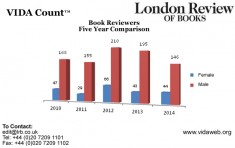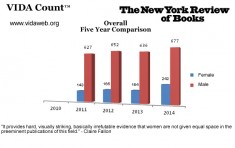April 8, 2015
Few surprises from the 2014 VIDA Count
by Zeljka Marosevic
Drum roll please. The 2014 VIDA Count has been revealed. Vida represents Women in Literary Arts and undertakes an annual survey to profile the gender (and now race) of contributors writing for leading literary publications.
The results of last year’s VIDA Count from 2013 caused something of a furore, so poor was the representation of women in a number of prominent journals, most notably the London Review of Books and the New York Review of Books. The reactions from these publications also made headlines. This year, the organisation did three counts: the 2014 VIDA Count, the second annual Larger Literary Landscape VIDA Count (looking at smaller publications from across America) and the first annual 2014 Women of Colour VIDA Count.
So what about the past year, have things improved? Is there anything to hope for?
Well, sort of.
Vida have summarised their most interesting observations on their website, and it’s well worth reading for an in-depth picture of male and female representation in magazines today. Of particular note:
We are cautiously pleased to note that Harper’s deputy editor, Christopher Beha, followed through on last year’s public proclamation for improvement. Harper’s overall numbers for women increased 6 percentage from 2013 – 2014. Specifically, female Book Reviewers grew by 11 percentage points, from 29 percent to 40 percent of the total reviewers, and female-penned bylines increased by 10 percentage points.
So too, things were looking up at The New Republic:
Lo, The New Republic observed last year that their numbers were “more what you would expect from 1964 than 2014.” Their promise for change has found legs. Their 2013 female Book Reviewers’ sad 7 percent has made strides in 2014 to 29 percent. That’s an increase of 22 percentage points. Further, authors reviewed shows a gain of 10 percentage points, with an overall five percentage points improvement. Baby steps!
While Granta is almost close to complete gender parity:
Granta is steadily closing the gap. Since 2012, it has moved at a pace of a 3 percentage points increase per year. If this trend continues, in 2015 women will represent 51 percent of Granta’s overall contributors!
At the New York Times Book Review, readers will be pleased to hear that there has been some progress:
In 2010, women comprised 38 percent of the overall pie. That share of the pie remained fairly consistent until 2013, when women comprised 45 percent of the pie. The gap closed even further in 2014 with a 2 percentage point increase to 47 percent, nearing parity.
The LRB published fewer reviews overall but the numbers of female reviewers rose from 43 out of total of 238 in 2013, to 44 out of 190 in 2014, a real improvement:
And there was also overall improvement at the NYRB:
This year, Vida singled out the Paris Review and the TLS as having plenty of room for improvement:
Though The Paris Review made great strides toward gender parity last year, this year’s tallies show negative change for women on all counts. In 2013, women represented 51 percent of the pie, a milestone we celebrated. However, this year’s counts point to a sharp decline, an 11 percentage point slide to just 40 percent female and 60 percent male overall.
While at the TLS:
Overall, we haven’t seen significant positive change at The Times Literary Supplement over five years of our counting. The share of the pie for women has remained at a consistent 27 percent for four years. In 2014, we saw a slight bump to 28 percent, which means that women continue to share less than one third of the pie.
As for the results of the first Women of Colour VIDA Count, the organisers identified some issues in their methodology:
Throughout the process of attempting to locate contact information, I received several responses from writers who wrote to let me know that they were providing their email addresses but that they were not ‘a woman of color.’ Anyone who uses surveys knows to account for a certain amount of apathy and misunderstanding, but what does the latter response imply about this particular count and its reception? Would you open an email that had “2014 Women of Color VIDA Count” in the subject heading? We hope to gather responses to such questions as we move forward, so that we may cull a larger number of respondents next year, as well as understand the causes for those who chose to either ignore or declined to respond.
Unfortunately this means the results do not make for a “statistically sound study” from which to draw conclusions. But even a quick look at the charts shows the inevitable. A purple bar indicates the number of writers who identify as “White”. The purple bar for every one of the publications profiled rockets up towards the top of the chart, leaving all other identities far behind.
In general, though, Erin Belieu, the co-founder of Vida had some positive remarks about this year’s survey and the continued impact of Vida, as the Guardian reports:
Our goal has always been consciousness not quotas. Art doesn’t get made by quotas and some years it’s going to go forward, some years it’s going to slide back a little bit, but over time what we hope for is a shift in consciousness. We want editors, readers and writers to be aware of their habits and open their mind to other voices, and we at Vida do really think that is genuinely happening. And I would say overall we have seen a lot of positive trends over the duration of the five years we’ve compiled these figures.
Zeljka Marosevic is the managing director of Melville House UK.


